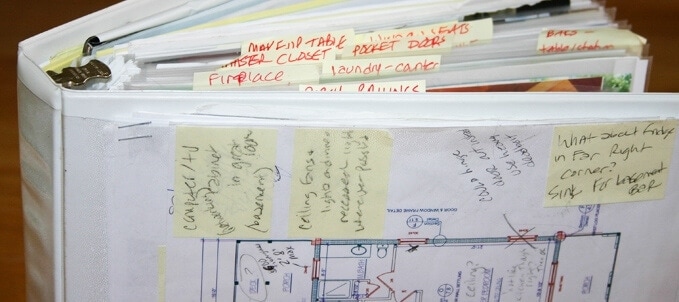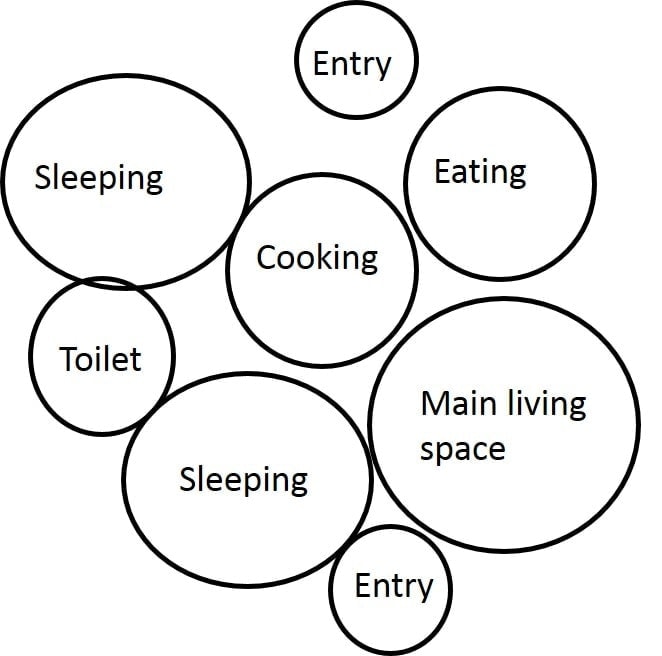Why make a home design notebook?
Your professional architect or home designer will be best able to create the home of your dreams, if you can show them what your dreams are. So you need to do lots of homework.
- First you need to discover what you want, by searching for inspiration, in magazines, the internet, or other places.
- Then you need to organize your ideas so they make some sense.
- Last, you need to communicate your ideas to your design professional.
 Searching for inspiration :
Searching for inspiration :
Of course, in the age of the internet, there are more pictures out there than we can list. Here are a few of our favorite sources:
- Timber Home Living http://www.timberhomeliving.com/ Specific to timber frame homes
- HGTV Photo Library: http://photos.hgtv.com/rooms . Search by room type, style, and color
- Better Homes and Gardens http://www.bhg.com/ Lots of decorating ideas, plus house plans
- Elle Décor http://www.elledecor.com/design-decorate/ Design, decoration, even recipes!
Pinterest has many boards on home design. A few we have found to be loaded with good info:
- Neal’s Design-Remodel https://www.pinterest.com/nealsdesign/
- Homebunch https://www.pinterest.com/source/homebunch.com/
- Space Planning/Design https://www.pinterest.com/angelinagraham/space-planningdesign/
- Renovation | Design | Space Planning https://www.pinterest.com/goofnutdesigns/renovation-design-space-planning/
- Space Planning & Design https://www.pinterest.com/rtw13/space-planning-design/
- All Space Planning Pins https://www.pinterest.com/search/pins/?q=space+planning+design
- Interior Design Ideas https://www.pinterest.com/designpronews/
Houzz has really taken off and is a great source for inspiration. Search photos by room, search for professionals, or even shop for furnishings http://www.houzz.com/
Attend Home Shows!
Search the internet for shows in your area or head to:
- American Consumer Shows https://www.acshomeshow.com/
- The Log and Timber Home Show http://www.thelogandtimbershow.com/
Remember to print and save pictures that appeal to you so you can share them with your design professional – or save them to a file on your computer. Better yet, save them in “the cloud” so you can share them from your mobile device! Make notes on them right away, pointing out what part of the space you are drawn to.
Organize Your Ideas – Create a Binder
Purchase a 3’ wide, 3-ring binder, with pockets. You need to have enough room for brochures, drawings, magazine clippings, etc. You may want to buy hole-punched sheet protectors, to insert your magazine clippings easily.
- Organize the notebook into sections with tabbed dividers. You can organize your ideas by room of the house. Also, you can have sections for finishes, appliances, doors and windows, etc. You can have a section for your programming, bubble flow diagrams, etc.
- Have a section filled with blank notebook paper , for adding notes and suggestions you gain from talking to professionals and visiting showrooms.
Communicate Your Ideas
Now that you have gathered inspiration and organized your ideas, you are starting to develop a strong idea of what you want in your home. You can communicate this to the professionals by taking your binder to all meetings and showing them what you have compiled. Be prepared to listen to their thoughts on your ideas. With their experience, they may present you with more effective ways to achieve your vision.

Another step in communicating your vision for your home is to develop a schematic for the arrangement of spaces. This is called a Bubble Flow Diagram. The professionals will use more involved methods, but here is an easy way for you to describe how you want the spaces in your home to relate to each other:
- On a blank piece of paper, draw circles to represent the different spaces you want in your home. Try to draw smaller spaces for smaller areas (like bathrooms and bedrooms), and larger spaces for larger areas (like living rooms). Label each circle so you remember what it represents.
- Cut out the circles, and lay them on another piece of paper. Now you can easily move the circles around on the paper until you get the spaces arranged how you want them. Think particularly about which spaces should be close to each other, and which should be separated. Once you have the spaces laid out to suit you, tape them down!
- Take your Bubble Flow Diagram to your design meetings, and be prepared to talk about the pros and cons of what you have planned with your designer. They will take it from here!
Your Homework Will Pay Off !
All of this takes a lot of time, but the more you research the possibilities, know what you want, and the better you communicate that to the professionals, the closer your home will be to the ideal place you have in your mind.
Enjoy the process!